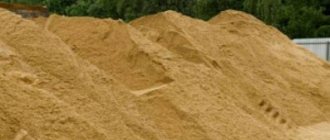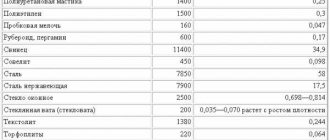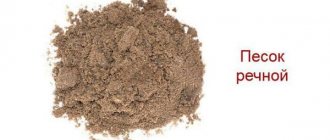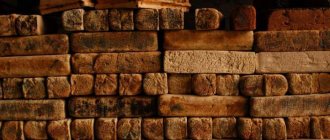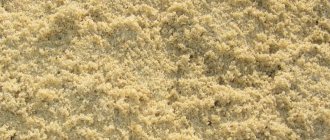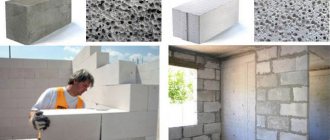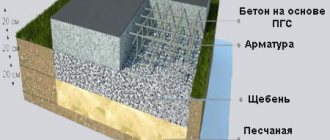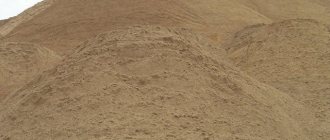Heat capacity, heat absorption and inertia. Specific heat capacity of sand Specific heat capacity of materials
Sand is considered the most common material
that is used in all spheres of human activity, especially in construction. There is hardly a modern building where sand is not used as a constituent material. It is used for concrete mixture or ordinary mortar for laying a brick wall. The heat capacity of sand will be discussed in the article.
Advantages
Sand has a number of advantages,
thanks to which the building is in use for many years. The main ones include:
- seismic resistance;
- tolerates sudden temperature changes, from severe frosts to hot climates;
- low compression
of the material helps to place a heavy base on it, and at the same time additionally cushion the entire building. This is especially true in areas with frequent earthquakes; - water permeability, which allows the purification of many liquids;
- wide range of applications in other areas.
For the convenience of determining the heat capacity of a material, in this case sand, ready-made tables are used that contain calculations. They are used by builders to carry out calculations.
Thermal conductivity is also important,
taken into account when planning thermal insulation work.
Selecting the right material is very important; it determines how much thermal energy you will have to expend to heat the finished room. The problem is the low heat capacity of the sand material and the finished room, especially if it is a residential building, requires additional thermal insulation.
Thermal conductivity depends on the density of the material itself. Another important point is the moisture content of the sand. As indicated in the table below, as it increases, the thermal conductivity of the sand material also increases.
Table - expression of the main parameters of sand thermal conductivity
This table will help both novice builders and those who are not new to this business to quickly and accurately calculate the required amount of sand material for future construction. and the heat capacity is 840 Jkg*deg.
If wet river sand is used, then the parameters will be as follows: a mass of 1900 kgm3 has a thermal conductivity of 0.814 W m*deg, and a heat capacity of 2090 Jkg*deg.
All this data is taken from various manuals on physical quantities and thermal engineering tables, where many indicators are given specifically for building materials. So it will be useful to have such a book with you.
What is the best sand to use for making concrete?
The widespread use of sand in construction work allows us to expand the range of applications. It is a universal remedy
to prepare various types of solution:
- for concrete mixtures;
- on ;
- walls;
- laying walls with blocks or bricks
; - filling of load-bearing slabs;
- production of a monolith.
You can list more, the main thing is to understand the essence. But when constructing various types of structures, sand with different compositions and properties is used.
A unique property of transition from a loose state to a dense one. Allows the use of this material for protective and natural shock absorption of the base of the structure.
If we highlight the production component of concrete, then construction organizations and private builders give preference to river sand. Its properties allow you to start using it without additional manipulations such as washing, such as in a quarry.
The purest sand among the mined sands is that which is mined from the bottom of active rivers. It undergoes additional washing treatment and can be immediately used for its intended purpose. The homogeneous mass and the absence of unnecessary impurities make this type of sand the most popular, despite the cost.
- a special material and requires precise calculation of the proportions of the components, and its quality depends on the presence of clay rocks in the sand. After all, the properties of clay envelop sand grains of the extracted material, which directly affects the high-quality adhesion of sand to other components of the concrete mixture, including cement.
According to characteristics, sand is also divided into classes
:
- first grade;
- second class;
- special sands.
Each of the listed groups is used for the use of concrete products, but only for a narrow circle. For example, the first class is used for casting concrete, whose main characteristics are:
- quality;
- high resistance to external influences;
- sudden changes in temperature, including frost resistance.
Sands belonging to the second class are used only for the manufacture of materials that do not require increased moisture resistance, for example, for tiles or facing structures.
Special sand mixtures are necessary when constructing concrete or reinforced concrete structures. Such mixtures make it possible to enhance a number of indicators for compression and resistance to changes in atmospheric environments.
For more information about the properties and use of sand, watch the video:
The creation of an optimal microclimate and the consumption of thermal energy for heating a private house during the cold season largely depends on the thermal insulation properties of the building materials from which the building is constructed.
One of these characteristics is heat capacity. This value must be taken into account when choosing building materials for constructing a private house. Therefore, the heat capacity of some building materials will be considered next.
Definition and formula of heat capacity
Each substance, to one degree or another, is capable of absorbing, storing and retaining thermal energy. To describe this process, the concept of heat capacity was introduced, which is the property of a material to absorb thermal energy when heating the surrounding air.
To heat any material with mass m from temperature t start to temperature t end, you will need to spend a certain amount of thermal energy Q, which will be proportional to the mass and temperature difference ΔT (t end -t start). Therefore, the heat capacity formula will look like this: Q = c*m*ΔТ, where c is the heat capacity coefficient (specific value). It can be calculated using the formula: c = Q/(m* ΔТ) (kcal/(kg* °C)).
Conventionally assuming that the mass of the substance is 1 kg, and ΔТ = 1°C, we can obtain that c = Q (kcal). This means that the specific heat capacity is equal to the amount of thermal energy that is expended to heat a material weighing 1 kg by 1°C.
Using heat capacity in practice
Building materials with high heat capacity are used for the construction of heat-resistant structures.
This is very important for private houses in which people live permanently. The fact is that such structures allow you to store (accumulate) heat, thanks to which the house maintains a comfortable temperature for quite a long time.
First, the heating device heats the air and the walls, after which the walls themselves warm the air. This allows you to save money on heating and make your stay more comfortable.
For a house in which people live periodically (for example, on weekends), the high thermal capacity of the building material will have the opposite effect: such a building will be quite difficult to heat quickly.
The heat capacity values of building materials are given in SNiP II-3-79. Below is a table of the main building materials and their specific heat capacity values.
Table 1
Brick has a high heat capacity, so it is ideal for building houses and constructing stoves.
Speaking about heat capacity, it should be noted that heating stoves are recommended to be built from brick, since the value of its heat capacity is quite high. This allows you to use the stove as a kind of heat accumulator.
Heat accumulators in heating systems (especially in water heating systems) are used more and more every year.
Such devices are convenient because they only need to be heated well once with the intense fire of a solid fuel boiler, after which they will heat your home for a whole day or even more. This will significantly save your budget.
Heat capacity of building materials
What should the walls of a private house be like in order to comply with building codes? The answer to this question has several nuances. To understand them, an example will be given of the heat capacity of the 2 most popular building materials: concrete and wood. has a value of 0.84 kJ/(kg*°C), and wood – 2.3 kJ/(kg*°C).
At first glance, you might think that wood is a more heat-intensive material than concrete. This is true, because wood contains almost 3 times more thermal energy than concrete.
To heat 1 kg of wood you need to spend 2.3 kJ of thermal energy, but when cooling it will also release 2.3 kJ into space.
At the same time, 1 kg of concrete structure can accumulate and, accordingly, release only 0.84 kJ.
But don't rush to conclusions. For example, you need to find out what heat capacity 1 m 2 of concrete and wooden walls 30 cm thick will have. To do this, you first need to calculate the weight of such structures. 1 m2 of this concrete wall will weigh: 2300 kg/m3 * 0.3 m3 = 690 kg. 1 m 2 of wooden wall will weigh: 500 kg/m 3 * 0.3 m 3 = 150 kg.
- for a concrete wall: 0.84*690*22 = 12751 kJ;
- for a wooden structure: 2.3*150*22 = 7590 kJ.
From the obtained result we can conclude that 1 m 3 of wood will accumulate heat almost 2 times less than concrete.
An intermediate material in terms of heat capacity between concrete and wood is brickwork, a unit volume of which under the same conditions will contain 9199 kJ of thermal energy. At the same time, aerated concrete, as a building material, will contain only 3326 kJ, which will be significantly less than wood.
However, in practice, the thickness of a wooden structure can be 15-20 cm, when aerated concrete can be laid in several rows, significantly increasing the specific heat capacity of the wall.
1017 07/27/2019 5 min. It is generally accepted that any sand is suitable for construction work. But that's not true. Firstly, it is necessary to use only special construction types. Secondly, it is necessary to take into account their individual characteristics.
The specific gravity and heat capacity of this material play an important role when choosing one of its types, and they will be discussed in this article.
Classification
Its specific characteristics depend on the type of material. There are several varieties of it. By origin it is divided into natural and artificial. The first type, depending on the place of extraction, has the following varieties:
Career
Quarry sand is extracted as a result of the destruction of rocks. Its grains can be from 0.16 to 3.2 mm. Due to the nature of the extraction, it turns out to be of low quality, as it contains many impurities in the form of clay and dust.
Crushed
It is obtained through the destruction and grinding of rocks. This process takes place using special equipment, so the extraction of this sand is reflected in its high cost. Due to the resulting irregular shape, sand grains bind well to each other and to other building materials. When adding such material, concrete consumption is reduced.
Application
: It is used for concrete structures, when pouring roads and paths, and also as a filler for dry mixtures.
The above varieties of sand differ in color. Thus, the quarry variety has a yellow and brown tint, while the river variety is found in cream and gray colors.
Artificial
It is considered as such because it undergoes special processing, after which a material is obtained that differs in properties from its original. Created by crushing natural stones.
Quartz
It is the most popular of all artificial species. It is obtained by grinding white quartz. After certain processing, a homogeneous composition without impurities is produced. This feature makes it possible to calculate the exact dimensions of the future structure.
Application
: The quartz type is widely used in finishing and decorative works; sometimes it is added when creating cement mortar, but this happens extremely rarely. It is commonly found in paints, putties and drainage filters.
There is also molding sand, it is used during molding in metal models.
Determination of magnitude
This value is equal to the mass contained in a unit volume. In other words, density. Most often in reference literature it is measured in g/cm3 or kg/m3.
The specific gravity of sand depends on the amount of impurities it contains and the moisture content of the material. High water content increases the specific gravity per unit volume. Also, this indicator will depend on the location of sand storage, which can be:
- natural occurrence;
- arrangement of material in bulk;
- artificial compaction.
The same type of sand under these conditions will have different values.
According to GOST 8736-77 it is indicated that the specific gravity of construction sand can vary from 1150 to 1700 kg/m 3.
As an example, the table shows several meanings of its individual varieties.
| Type of sand | Specific gravity in kg/1 m 3 |
| River alluvial sealing | 1200-1700 |
| 1650 | |
| 1590 | |
| Career | 1500 |
| Nautical | 1620 |
| Quartz | 1600-1700 |
| Wet | 1920 |
Heat capacity
This is the ability of a material to accept, accumulate and retain energy. Heat capacity is an indicator of the thermophysical properties of sand. The ability to heat up depends on the chemical composition, structure and amount of material used. Therefore, the overall indicator will depend on its dryness. Important for cement compositions and when concreting walls.
| Kind of sand | Specific heat capacity in kJ/kg per 1 0 |
| Wet quartz | 2,09 |
| River dry | 0,8 |
| Career | 0,84 |
| Nautical |
Source: https://2balla.ru/teplo-mkost-teplousvoenie-i-inerciya-udelnaya-teploemkost.html
content .. 11 12 19 ..4.2. Technical ceramics
Technical ceramics is a material obtained by sintering various oxides and inorganic compounds. Ceramics have found wide application in the nuclear, electrovacuum, electrical, electronic, radio engineering industries and in other types of production. Of the variety of ceramic materials, we will look in more detail only at corundum (VK94-1, VK91-2) and bromellitic (VB100-1) ceramics, which are widely used for technical purposes. When marking ceramics, the first letter indicates the class of ceramics (B - vacuum), the second - the main mineral (K - corundum, B - bromellite), numbers rounded to the nearest whole number correspond to the nominal content of the main components (94 and 91% corundum, 99.5 % bro-mellig), and the last number after the hyphen is the development number.
Corundum ceramics VK94-1 consists of 94.40% corundum (aluminum oxide, alumina), 2.76% silicon dioxide, 0.49% chromium oxide and 2.35% manganese dioxide. Insulators of various configurations, technological equipment and other products are made from corundum ceramics by casting. After sintering, the parts acquire the physical and mechanical properties inherent in this ceramic and acquire a color - pink or lilac.
Corundum ceramics VK94-1 has a number of advantages over the best types of glass and other types of ceramics and is characterized by high mechanical strength and vacuum density, thermal and chemical resistance, low electrical losses in a wide range of frequencies and temperatures, a wide range of sintering temperatures, and structural stability. In addition, corundum ceramics is non-toxic; it consists of three phases: crystalline (crystals of the main refractory component - A1203 corundum, forming a strong frame); glassy (glass phase - a solution of corundum in a mineralizer - a component that regulates the sintering of Mn02 - Si02 - Cr2O3); gaseous (small content (less than 0.02%) of pores). In the finally fired state, corundum ceramics is a densely sintered crystalline frame with the glass phase evenly distributed throughout the volume.
In addition to corundum ceramics VK94-1, corundum ceramics VK91-2 is quite widely used in production, which consists of 91.5% alumina (corundum), 5.9% silicon dioxide, 0.5% magnesium oxide, 1.2% calcium oxide and 0.9% zirconium dioxide. VK91-2 ceramics have approximately the same dielectric constant and dielectric loss tangent as VK94-1 ceramics, but lower values of volumetric electrical resistivity (1,000 times) and electrical strength (5 times).
Bromellite, or beryllium, ceramics (bromellite) is sintered beryllium oxide BeO and is used for the manufacture of insulators, substrates and other device parts. This ceramic has a unique set of thermal, electrical, chemical and mechanical properties and is therefore increasingly used in various fields of technology. Bromellite ceramics have found application in the production of devices due to their extremely high thermal conductivity and good electrical insulating properties. ^
The thermal conductivity of bromellite ceramics at 20 °C is (1.67...2.52) • 102 W/(m • K), which is 7 times higher than the thermal conductivity of corundum ceramics and corresponds to the level of thermal conductivity of steel, aluminum and lead. With increasing temperature, the thermal conductivity of bromellite decreases sharply, nevertheless remaining higher than the thermal conductivity of other ceramic materials and some metals. Thus, at a temperature of 100 °C, the thermal conductivity of bromellite ceramics is 2 times less than the thermal conductivity of copper, but 120 times greater than the thermal conductivity of corundum ceramics and approaches the thermal conductivity of high-purity aluminum. At temperatures of 1,000…1,500 °C, the thermal conductivity of bromellite ceramics is 3–8 times higher than the thermal conductivity of corundum ceramics. In addition, the thermal conductivity of bromellite depends on the amount of impurities and increases with their decrease
and, conversely, decreases with increasing amount of impurities. With decreasing density, the thermal conductivity of bromellite ceramics decreases and, at a porosity of 25.5%, reaches a level of approximately 26.5% of the thermal conductivity at zero porosity. Thus, bromellite ceramics are an excellent conductor of heat.
The specific heat of bromellite at room temperature is 1.1 * 1000 J/(kg • K), which is significantly higher than the specific heat of corundum and all metals (except beryllium). As the temperature rises, the specific heat capacity of bromellite drops sharply. Having the highest heat capacity among all other types of ceramics, bromellite is an excellent heat absorber.
Bromellite ceramics have high thermal resistance due to its unique thermal conductivity. The melting point of bromellite is 2,650 °C, and the maximum operating temperature is in the range of 1,500 ... 2,316 °C. This ceramic performs well under thermal cycling. As the temperature increases, the LTEC of bromellite increases and, for example, for the temperature range 25...600°C it is 0.6 * 10-6 1/K.
Thermal resistance and thermal expansion coefficient of bromellite are also the most important parameters taken into account. The high heat resistance of bromellite ensures the necessary climatic reliability over the entire operating temperature range.
Heat capacity of materials - table
In construction, a very important characteristic is the heat capacity of building materials.
The thermal insulation characteristics of the walls of the building depend on it, and, accordingly, the possibility of a comfortable stay inside the building.
Before you begin to familiarize yourself with the thermal insulation characteristics of individual building materials, you need to understand what heat capacity is and how it is determined.
Specific heat capacity of materials
Heat capacity is a physical quantity that describes the ability of a material to accumulate temperature from a heated environment.
Quantitatively, specific heat capacity is equal to the amount of energy, measured in J, required to heat a body weighing 1 kg by 1 degree.
Below is a table of the specific heat capacity of the most common materials in construction.
In order to calculate the heat capacity of a particular material, you must have the following data:
- type and volume of heated material (V);
- the specific heat capacity of this material (Sud);
- specific gravity (msp);
- initial and final temperatures of the material.
Comparative characteristics of the heat capacity of basic building materials
In order to compare the heat capacity of the most popular building materials, such as wood, brick and concrete, it is necessary to calculate the heat capacity for each of them.
First of all, you need to decide on the specific gravity of wood, brick and concrete. It is known that 1 m3 of wood weighs 500 kg, brick - 1700 kg, and concrete - 2300 kg. If we take a wall whose thickness is 35 cm, then through simple calculations we find that the specific gravity is 1 sq.
m of wood will be 175 kg, brick – 595 kg, and concrete – 805 kg. Next, we will select the temperature value at which thermal energy will accumulate in the walls. For example, this will happen on a hot summer day with an air temperature of 270C.
For the selected conditions, we calculate the heat capacity of the selected materials:
- Wall made of wood: C=SudhmuddhΔT; Sder=2.3x175x27=10867.5 (kJ);
- Concrete wall: C=SudhmuddhΔT; Cbet = 0.84x805x27 = 18257.4 (kJ);
- Brick wall: C=SudhmuddhΔT; Skirp = 0.88x595x27 = 14137.2 (kJ).
From the calculations made, it is clear that with the same wall thickness, concrete has the highest heat capacity, and wood has the least. What does this mean? This suggests that on a hot summer day, the maximum amount of heat will accumulate in a house made of concrete, and the least amount of heat will accumulate in a house made of concrete.
This explains the fact that in a wooden house it is cool in hot weather and warm in cold weather. Brick and concrete easily accumulate a fairly large amount of heat from the environment, but just as easily part with it.
Heat capacity and thermal conductivity of materials
Thermal conductivity is a physical quantity of materials that describes the ability of temperature to penetrate from one wall surface to another.
To create comfortable indoor conditions, it is necessary that the walls have a high heat capacity and a low thermal conductivity coefficient. In this case, the walls of the house will be able to accumulate thermal energy from the environment, but at the same time prevent the penetration of thermal radiation into the room.
Source: https://stroydetali.com/teploemkost-materialov-tablica_/
Thermal conductivity and heat capacity of materials
Thermal conductivity
Thermal conductivity is the ability of a material to conduct heat flow through its thickness in the presence of a temperature difference on the surfaces limiting the material. An indicator of thermal conductivity is the thermal conductivity coefficient λ. Sometimes thermal conductivity is expressed by the reciprocal of λ—thermal resistance (R = 1 / λ).
The thermal conductivity coefficient depends on the nature of the material, its structure, porosity and humidity. A material with a crystalline structure is usually more thermally conductive compared to a material with an amorphous structure. The thermal conductivity coefficient of laminated (laminated plastics) and fibrous (wood) materials significantly depends on the direction of heat flow in relation to the layers or fibers. So, in wood along the grain it is approximately twice as large as across it.
The larger the pores in the materials, the larger the λ value. The coefficient decreases with decreasing average density of homogeneous materials, and materials with developed porosity and low humidity have the lowest thermal conductivity. When the material is moistened, its thermal conductivity increases, since the thermal conductivity coefficient of water is approximately 25 times greater than that of air. Below are the thermal conductivity coefficients of various materials, W / (m °C); For comparison, the values of λ of water and air are given:
concrete is heavy…………. 1.28—1.55
clay brick………. 0.70—0.85
along the grain 0.30
across the grain 0.17
mineral wool 0.06—0.09
thermal insulating concrete. .0.03—0.08
Thermal conductivity is of practical importance when choosing materials for external walls, floors and coatings of buildings, insulation of heating networks, refrigerators, boilers, etc.
Heat capacity
Heat capacity is the property of a material to absorb heat when heated and release it when cooled. The ratio of heat capacity to a unit amount of material (by mass or volume) is called specific heat capacity, which is numerically equal to the amount of heat (in J) required to heat I kg of material by I °C. The specific heat capacity, kJ/(kg -°C), of the materials below is:
aluminum alloys 0.90
natural stone materials 0.75—0.93
heavy concrete 0.80—0.92
Heat capacity is taken into account when determining the thermal stability of external fences of heated buildings (materials with the highest specific heat capacity are required), when calculating the heating of the components of concrete and mortar, as well as mastics for work in winter, etc.
Heat capacity of building materials (specific): table
The creation of an optimal microclimate and the consumption of thermal energy for heating a private house during the cold season largely depends on the thermal insulation properties of the building materials from which the building is constructed.
One of these characteristics is heat capacity. This value must be taken into account when choosing building materials for constructing a private house. Therefore, the heat capacity of some building materials will be considered next.
Properties and classification of building materials.
Tree
For comfortable living in a home, it is very important that the material has high heat capacity and low thermal conductivity.
In this regard, wood is the best option for houses not only for permanent but also for temporary residence. A wooden building that is not heated for a long time will respond well to changes in air temperature. Therefore, heating of such a building will occur quickly and efficiently.
Coniferous species are mainly used in construction: pine, spruce, cedar, fir. In terms of price-quality ratio, the best option is pine.
Whatever you choose to design a wooden house, you need to consider the following rule: the thicker the walls, the better.
However, here you also need to take into account your financial capabilities, since with an increase in the thickness of the timber, its cost will increase significantly.
Brick
This building material has always been a symbol of stability and strength. The brick has good strength and resistance to negative environmental influences.
However, if we take into account the fact that brick walls are mainly constructed with a thickness of 51 and 64 cm, then in order to create good thermal insulation they additionally need to be covered with a layer of thermal insulation material.
Brick houses are great for permanent residence. Once heated, such structures are capable of releasing the heat accumulated in them into space for a long time.
When choosing a material for building a house, you should take into account not only its thermal conductivity and heat capacity, but also how often people will live in such a house. The right choice will allow you to maintain coziness and comfort in your home throughout the year.
Source
Source: https://thewalls.ru/stroitelstvo/teploemkost-stroitelnyh-materialov-udelnaya-tablitsa.html
Specific gravity of sand: volumetric construction kg m3, GOST quartz, river density, heat capacity
It is generally accepted that any sand is suitable for construction work. But that's not true. Firstly, it is necessary to use only special construction types. Secondly, it is necessary to take into account their individual characteristics.
The specific gravity and heat capacity of this material play an important role when choosing one of its types, and they will be discussed in this article.
River
It is mined from the bottom of the river and has smaller particles than the quarry type - 0.3 to 0.5 mm. This sand material has a purer fraction and contains virtually no impurities. River sand is purified naturally.
You can find out how to use quarry sand here in the article.
When in contact with water, its particles are polished and have smooth edges, which is why their rounded shape does not adhere well to other substances, even when water is added. When using it, it must be taken into account that more cement will be used than when using other types of sand.
Application : It is used when laying roads, added to cement mortar for the construction of houses, for making cement screeds, drainage structures, water purification filters. You just need to take into account that this type of sand in solution tends to settle into sediment, so it must be constantly stirred.
You can find out what the composition of river sand is in this article.
Alluvial
High-quality material, with a minimum content of impurities. But its extraction is a labor-intensive and expensive process, which is carried out using special equipment.
This consumes a large amount of water. Necessary for washing out various inclusions from sand.
Ultimately, the material is of excellent quality, but due to its high cost, it is used less often than the same quarry material.
You can find out where and under what conditions coarse quarry sand is mined by reading this article.
Application : It is an indispensable material for creating solutions intended for internal and external cladding work. Also used in other construction processes.
Nautical
It is considered the highest quality type. It is extracted by hydraulic projectiles from the bottom of the sea and then undergoes double processing:
- the first occurs during sand extraction; with its help, unnecessary impurities in the material are cut off;
- the second is a hydromechanical method. Consists of processing sand in places where it accumulates.
Application : This type is the most popular; it is used for the construction of concrete structures and for creating finely dispersed building mixtures. It is used everywhere, but due to limited production, difficulties arise in purchasing the material.
You can find out the density of quarry sand per 1 kg m3 in this article
